Acknowledgement
Special thanks to my children: Evita and Nicholas, for being my inspiration.
ELT Character Education in the 21st Century: The Power of Kindness, the Power of ELT
Margarita Kosior, Greece
Margarita Kosior, born in Poland and based in Greece, is a passionate storyteller, a tertiary educator teaching Academic English and trainer at Language Teaching Methodology at the Bachelor's and Master's levels. She is also interested in ELT at the pre-K level. As an advocate for social justice she believes in spreading awareness of global issues through ELT. As a mother of two bilingual children, she is a strong supporter of bilingual and multilingual education. As a curious trend-spotter, she is always on the lookout for current approaches and methods in language teaching. E-mail: margaritakosior@gmail.com

Menu
Introduction
Background
Practical applications
References
The world is changing. Our lives are changing. The future begins now. The role of an educator is to make sure that their students are equipped with the knowledge and skills necessary to face the challenges of tomorrow. In many careers, fluency in English is no longer considered an asset, but is taken for granted. At the same time, accuracy is no longer as important as creativity, collaboration, or global thinking. Therefore, knowledge of English should not be considered a final destination, but rather a tool to acquire knowledge and skills, and to develop values which will later prove essential during the students' academic and professional careers.
Researchers often talk about life skills, soft skills or 21st century skills which students need to acquire in order to become successful learners and later professionals. These include, among others, creativity and innovation, communication and collaboration, negotiation, problem solving, digital citizenship, and many others. None of these, however, can be achieved without a proper set of values and principles, and one of the underlying core values for achieving many of these 21st century skills is kindness.
In many environments and in many circles, kindness is associated with weakness and showing kindness and generosity of heart often invites others to take advantage of us. As Piero Ferrucci, a psychotherapist and philosopher, explains: “It (kindness) is an aspect of our nature that we often do not express fully – especially men in our culture, but also women – because we are afraid that if this vulnerable side comes to light, we might suffer, be offended, ridiculed, or exploited” (Ferrucci, 2007). On the contrary, being strong is a sign of success and success can only be achieved by ruthless competitiveness; a common misconception. Therefore, success is associated with roughness and harsh tone with a quick wit. It has been proven, however, that kindness has a positive long-term impact on the people around us, but also on ourselves.
It is no exaggeration to say that kindness towards others starts with appreciation and love of self. People with low self-esteem and feelings of worthlessness tend to isolate themselves, do not express positive emotions towards others, live in anxiety and often turn to substances to enhance their mood. Such people are more likely to be bullied or become bullies themselves, or demonstrate some other form of violence. Low self-esteem in students will lead to lower academic success and lack of motivation. In terms of the relationships with others, children who are not taught to love themselves will demonstrate poor social skills. On the contrary, children who are taught compassion, empathy, kindness, empowerment and self-value and self-esteem, will live a happier life and radiate optimism. A good start in childhood will also positively influence their relationships with others, as they will exhibit a greater sense of family and community and will create better developed interpersonal relationships. Finally, in terms of their academic and professional careers, such students will achieve better academic success, demonstrate critical thinking skills and motivation to succeed. It also turns out that all the positive attitudes associated with kindness influence not only our relationships with others and our professional careers, but our health as well, by strengthening our immune system and reducing the negative effects of stress (Life Vest Inside, 2016). According to research led by Emily Ansell of the Yale University School of Medicine, an act of kindness as simple as holding a door open for someone can improve our mental condition and evoke positive emotions, relieving stress at the same time (Laguipo, 2015). Finally, engaging in an act of kindness reduces depression, and by producing the “happy” hormones - endorphins - relieves pain, and lowers blood pressure (Anon, 2016).
In more general terms, helping others makes us happy. Despite some claims that we often help others out of our selfish and ego-centric need to feel good about ourselves, a professor of psychology, Dacher Keltner claims that apparently “compassion is deeply rooted in our brains, our bodies, and in the most basic ways we communicate. What’s more, a sense of compassion fosters compassionate behavior and helps shape the lessons we teach our children” (Keltner, 2004). In the same essay, Keltner refers to the work of the Emory University neuroscientists James Rilling and Gregory Berns and their findings explaining: “Helping others triggered activity in the caudate nucleus and anterior cingulate, portions of the brain that turn on when people receive rewards or experience pleasure” (Keltner, 2004). In other words, they found that the act of helping another person and alleviating their suffering can be as rewarding as fulfilling a personal desire. Scientifically speaking, helping others activates the part of the brain responsible for the feelings of reward and reinforcement. In other words, being good can be addictive. The kinder we are, the more we want to be kind; a phenomenon referred to as “helper’s high” (Post, 2009 and Van Der Linden, 2011)
Despite all the positive evidence in favor of kindness, there is a lot of skepticism regarding how much really an individual can do in order to “make the world a better place.” Can an individual doing a good deed actually make a difference? It turns out that it is possible and that the phenomenon of the ripple effect or kindness boomerang are not just beautiful myths. The fact that kindness spreads was actually proven by research conducted by James Fowler of the University of California, San Diego and Nicholas Christakis of the Harvard University (University of California – San Diego, 2016) showing that kindness and generosity have contagious effects. Fowler and Christakis emphasize the link between their findings and the evolution of cooperation by saying: "The flow of good and desirable properties like ideas, love and kindness is required for human social networks to endure, and, in turn, networks are required for such properties to spread.” In other words, “groups with altruists in them will be more altruistic as a whole and more likely to survive than selfish groups” (University of California – San Diego, 2016); an interesting finding in light of the 21st-century focus on group work and collaboration.
“Receiving” kindness feels good, but so does spreading kindness. Therefore, Dr Price-Mitchell proposes four simple steps to increase children’s happiness: learn, create, share and practice. First, learn about the importance of kindness and its numerous benefits. Then, create activities to engage your students in performing acts of kindness and share experiences in order to reflect and gain even more from the activities. Finally, design an ongoing project, so that practicing kindness lasts longer than the lesson during which you discussed it with your students (Price-Mitchell, 2013).
The bottom line is that no essential learning can take place in an environment lacking kindness. Of course, skeptics will tell you that we already have too much on our plate and time constraints make it difficult if not impossible to test a new approach and incorporate additional material into our teaching. In response to that, in her work on integrating social, emotional and literacy learning, Mary Anne Buckley (2015) reminds us that our students should be our priority: young people shaping their characters and developing skills which will later allow them to function properly in work environments willed with various cultures, languages and experiences. Our role is to equip them with the skills they need to engage in successful communication and cooperation in the future. “Learning to communicate with kindness and respect allows all voices to be heard, all ideas to grow, and all people to succeed. Classrooms that foster kindness can provide students with the safety and security they need to become creative writers, inspired scientists, and innovative mathematicians while embodying tolerance, acceptance, and compassion for others” (p.88). With this in mind, our role extends beyond teaching and into the sphere of educating and facilitating; an additional responsibility for the teacher.
Fortunately, kindness can be taught and learnt, and the desire to help others can be developed with time through practice. Especially today, when so many things are going wrong in the world, it is the right time to spread kindness and encourage it in our students.
Below you will find a list of activities and recommendations, most of which can be used with and adjusted for relatively any age group and level, ranging from individual and group in-class activities to longer ongoing projects.
Activities building self-esteem are especially important, since, as indicated earlier, kindness towards others starts with kindness towards self. Sometimes children lose self-esteem and do not believe in their own potential. Our role as educators is to remind them how important they are without making them vain, to help them judge what their strengths are and recognize their own importance, but also to help them protect themselves from anything that lowers their self-esteem. It is especially important with young kids who believe any criticism they hear and a negative comment can actually shape who they are. In other words, their self-image is easily shaped by how others rate them. The idea behind creating a self-esteem mirror, dice or shield is to protect our learners from whatever lowers their self-esteem and to make them feel good about who they are, appreciate their own uniqueness and help them develop self-confidence.
It feels good to compliment others. It must feel at least as good to compliment ourselves. In this mirror each student writes five genuine compliments to themselves and then reads them out with confidence.
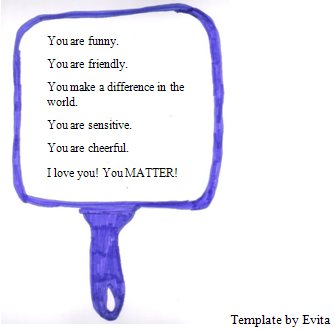
A self-esteem building dice and shield have a similar effect. Students take turns to roll the dice in order to finish positive statements about themselves: I am really good at…, I am great because…, Three things I love about me are…, The best compliment I ever got was…, I am special because… and Three words that best describe me are…, or fill out the four fields in a self-esteem shield:
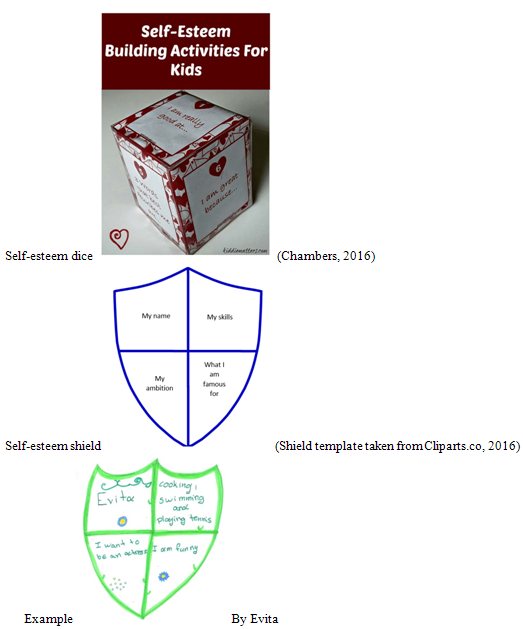
Moving on from individual to group projects it is important to remember that project become much more meaningful for our students once we provide them with an audience to admire their work. Classroom wall is a perfect space for that purpose. Beautifully decorated walls motivate students who are otherwise not always willing to participate in class and seeing the results of their work displayed for anyone to see motivates them to do the best they can. Moreover, creating big group projects to be pinned on the classroom bulletin boards or on classroom walls creates the sense of community and togetherness and strengthens the ties among the members of the group.
One of my favorite group projects is the one I like to call “Helping hands”. Students make a big poster of their hand prints. Each of them writes on their hand-print a good deed they have recently done. The process is fun and the results are colorful and meaningful. Students come up with a variety of good deeds, such as: give food to homeless people, help with housework, take care of my pet, help a friend with homework or say “good morning”. It is important to make our students realize that a good deed does not necessarily have to be something extraordinary; it can be something as simple as a smile or an “I’m sorry” note left on mum’s pillow after a fight.
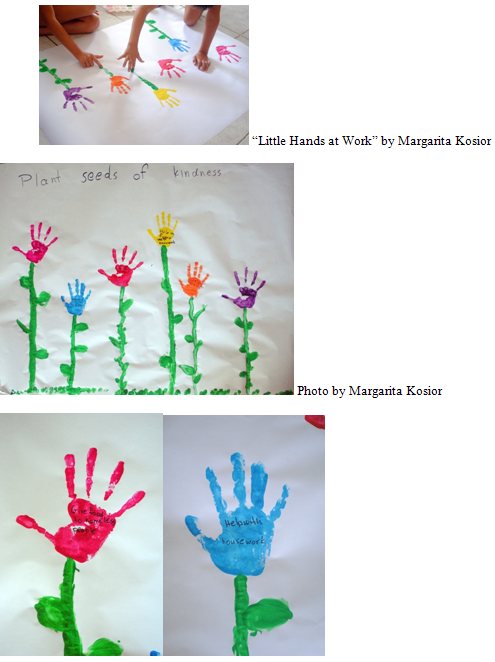
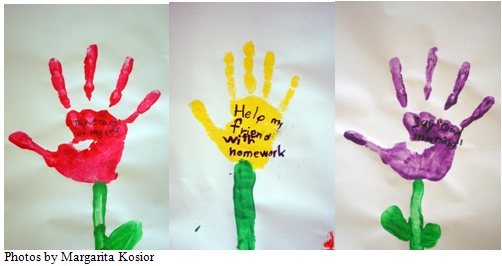
Another simple but meaningful activity for the whole group is the creation of a Kindness Tree on the wall of your classroom. Students write one good deed on a heart and are allowed to glue it up on the tree as soon as they have done the deed.
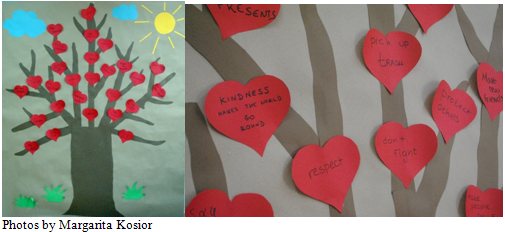
Older students can be usually easily motivated by starting a session with a silent discussion. Silent discussion is a collaborative learning strategy which helps students explore a topic in depth, but most importantly, it allows each student to work at their own pace and engages even the most intimidated students. It first takes form of written self-expression and exchange of ideas ultimately turns into a verbal discussion. The instructions need to be very clear: the participants are not allowed to talk during steps 1, 2 and 3. The only means of communication among them is a long stretch of big wrapping paper and markers.
Step 1
A silent discussion gets generated around a stimulus selected by the teacher. It can be a word, an image, a startling fact, or a quote which will arouse curiosity and serve as a springboard for discussion. It can be the word “kindness” itself or a quotation about kindness.
Step 2
The participants need to know the time limit. It is recommended that a silent discussion lasts at least 15 minutes. It is especially important in case of groups of students who are not familiar with this type of activity and need some time to get used to it. They will have to understand that silence plays an important role in the process and gives them an opportunity to think, "listen", respond, reflect, ask questions and answer questions posed by other participants.
Step 3
The group receives a big paper and markers in various colors. After the students have read the hint/stimulus, they start making written comments, asking questions and responding to questions posed by others by connecting these questions, answers and comments with lines. The outcome looks similar to a big mind map. It is important that the students know that a silent discussion is not a turn-taking activity; all students can be engaged in it simultaneously, which creates the atmosphere of a creative mess.
Step 4
Once the time is up, the students are given some time to step back, walk around and read through the whole discussion, identifying different areas and noticing how the conversation has got organized around certain points/topic statements.
Step 5
A regular discussion begins during which the participants draw conclusions from the silent stage of the activity. It is interesting to notice that even the shyest in the group are more confident to speak up and get their voices heard.
Most importantly, however, we should at all times encourage our students to be kind to each other. We all love to receive compliments; it boosts our self-confidence and self-esteem. Research shows that, just like with all acts of kindness, giving and receiving makes us feel equally good. This can be easily taken advantage of in the classroom. Remind your students that, instead of gossiping behind people’s back, you can try to focus on their features. During a class activity students leave a POSITIVE message ON the back on each classmate. Each participant holds a pen and has a A4 sheet with just three words “You rock because…” stuck on their back. Participants freely walk around leaving messages on their classmates’ backs. A teacher trainer, Mark Andrews (2016), refers to this as “The Message in the Back Massage”.
A similar activity can be done simply as a list of adjectives. Each students comes up with one adjective to describe each of their classmates. After collecting all the papers, the teacher compiles all the adjectives describing each student and creates a word cloud out of these, frames it, and gives it away as an end-of-the-year present (idea taken from Gr.pinterest.com, 2016)
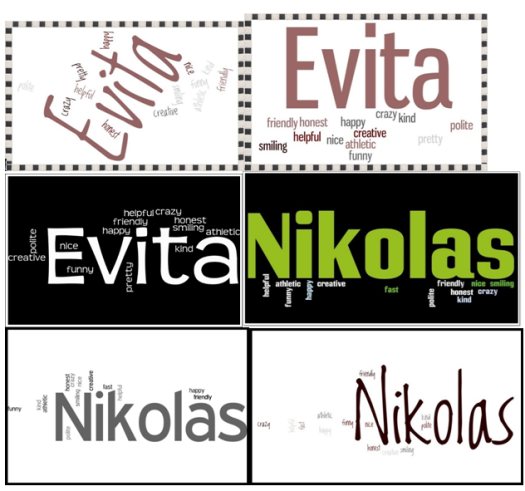
Watching and discussing movies is always a good idea and a pleasant break from the daily routine. Make sure that the movies you watch with your students have an important message to convey, but are appropriate for their age. A list of recommended movies about kindness might include: “Pay it Forward” (2000), “The Blind Side” (2009) and “Hotel Rwanda” (2004).
Similarly, watching inspirational videos enhances student involvement and motivation, and there are quite a few good ones about kindness:
- Kindness Boomerang (Life Vest Inside) https://www.youtube.com/watch?v=nwAYpLVyeFU
- Giving is the Best Communication https://www.youtube.com/watch?v=XADBJjiAO_0
- Selection of videos http://www.lifevestinside.com/education/resources/inspiring-videos/
- Generous Store https://www.youtube.com/watch?v=_cNfX3tJonw
- Kindness Scientist https://www.youtube.com/watch?v=sUcxoNFiomY
- The Science of Kindness (Life Vest Inside) https://www.youtube.com/watch?v=FA1qgXovaxU
- My 38 random acts of kindness: Botlhale Tshetlo at TEDxSoweto 2013 https://www.youtube.com/watch?v=QDGLoIxFZLk
Involving your students in kindness-related activities should not be just a one-off occurrence. Also, it is important to encourage our students not only to come up with ideas, but also to turn those ideas into action. Possibilities are countless including the following:
- Organize a Community Service Club in your school
- Prepare a video project with the students talking about their own acts of kindness
- Prepare a video boomerang group video (based on the “Kindness Boomerang” video by Life Vest Inside)
- Prepare a backpack for a needy person (a homeless person or a refugee): each student brings something they think a needy person might appreciate. The students put all the objects into one or several backpacks and give them to somebody in need
- Ask students to periodically reflect on their experience of performing acts of kindness by asking them questions such as and having them write down their answers in their kindness portfolio:
- What random act of kindness did you do and why?
- Whom did your random act of kindness benefit?
- Was your act of kindness worth the effort?
- How did it make you feel?
- What is the next act of kindness that you would like to try?
- Organize a research project about a personality who, through their kindness, made a difference in the world (e.g. Mother Teresa, Michael Jackson, etc.), resulting in a presentation (PowerPoint or poster)
- Get your students involved in the “67 minutes for Nelson Mandela” project within the scope of which each student devotes 67 minutes of their time to public service ranging from a small gesture to a global movement; one minute for every year of Mandela’s public involvement (More information at http://www.southafrica.info/mandela/67minutes.htm)
- Help your students prepare their own random act of kindness video based on “Kindness Boomerang” by Life Vest Inside
- Ask your students to email their kindness story to the Spread Kindness website http://www.spreadkindness.org/kindness-stories and see whose story gets posted or ask the students to post something on the official Spread Kindness Facebook page at https://www.facebook.com/SpreadKindness.org/posts
- Ask your students to find traditional proverbs about kindness and draw their representations on a big poster. Students can present their posters to class and have their classmates guess what the proverb says. Examples of proverbs which can be presented in a visual form include, but are not limited to the following:
- A kind word is like a Spring day. ~Russian Proverb
- Be a rainbow in someone else’s cloud. ~Maya Angelou
- “Kind words can be short and easy to speak, but their echoes are truly endless.” ~Mother Teresa
- Remember there’s no such thing as a small act of kindness. Every act creates a ripple with no logical end. ~Scott Adams
- Kindness does wonderful things to a face. ~Dixie Doyle
- Kind hearts are the gardens. Kind thoughts are the roots. Kind words are the blossoms. Kind deeds are the fruits. ~Kirpal Singh
- The fragrance always stays in the hand that gives the rose. ~Hada Bejar
- A kind heart is a fountain of gladness, making everything in its vicinity freshen into smiles. ~Washington Irving
- Every act of kindness is like a pebble thrown in a pond sending out ripples far beyond where the pebble entered the water. When we’re caring and kind to our neighbors, our actions send rings of kindness that spread from neighbor to neighbor to neighbor. ~Angela Artemis
Finally, you can always turn for inspiration to some of these websites devoted to spreading kindness:
- Random Acts of Kindness https://www.randomactsofkindness.org/
- Spreading Kindness http://www.spreadkindness.org/
- Kind Spring: Small Acts that Change the World http://www.kindspring.org/
- World Kindness Movement http://www.theworldkindnessmovement.org/
- Think Kindness https://thinkkindness.org/
Possibilities of involving students in a great kindness movement are countless and the satisfaction, tremendous. Using Long’s (2007) metaphor: "Just as sunlight is the source of energy that maintains organic life, kindness is the source of energy that maintains and gives meaning to humanity". No 21st-century learning can take place in an environment lacking kindness, whereas respectful interactions result in enhancement of such interpersonal skills as problem solving, collaboration, teamwork, or negotiation. Acts as simple as listening for a deeper and more meaningful understanding or valuing the contributions of others are tokens of appreciation and respect which prevent conflict and misunderstanding in the classroom, but also in the world out there.
Personally, I give my own struggle to spread kindness. I share some of my experiences on my blog “ELT for a Better World” (“Kindness” posted on 1 January 2016 and “Note to a Stranger” posted on 4 September 2016). “Changing the world… one student at a time” – a motto worth a try.
Andrews, M. (2016). The Message is in the Back Massage. [online] YouTube. Available at: https://www.youtube.com/watch?v=C8kEuqzp7YM [Accessed 3 Sep. 2016].
Buckley, M.A. (2015) Sharing the Blue Crayon. Portland, Maine: Stenhouse Publishers
Chambers, Y. (2016). Self-Esteem Building Activities for Kids - Kiddie Matters. [online] Kiddie Matters. Available at: http://www.kiddiematters.com/self-esteem-building-activities-for-kids/ [Accessed 3 Sep. 2016].
Cliparts.co (2016). Blank Family Crest Template Images & Pictures - Becuo - Cliparts.co. [online] Available at: http://cliparts.co/clipart/2352239 [Accessed 2 Sep. 2016].
Ferrucci, P. (2006). The Power of Kindness: The Unexpected Benefits of Leading a Compassionate Life. 2nd ed. New York, Tarcher/Penguin. Excerpts available at http://pieroferrucci.it/pdf/The%20Power%20of%20Kindness%20-%202006.pdf [Accessed 2 Sep. 2016].
Gr.pinterest.com (2016). [online] Available at: https://gr.pinterest.com/pin/34128909651254309/ [Accessed 2 Sep. 2016].
Keltner, D. (2004). The Compassionate Instinct. [online] Greater Good. Available at: http://greatergood.berkeley.edu/article/item/the_compassionate_instinct [Accessed 3 Sep. 2016].
Laguipo, A. (2015). Act Of Kindness Helps Reduce Effects Of Stress. [online] Tech Times. Available at: http://www.techtimes.com/articles/116401/20151217/act-of-kindness-helps-reduce-effects-of-stress.htm [Accessed 3 Sep. 2016].
Life Vest Inside (2016). [online] Available at: http://www.lifevestinside.com/wp-content/uploads/2014/05/Positive-and-Negative-Stats.pdf [Accessed 3 Sep. 2016].
Long, N. (2007). The therapeutic power of kindness. [online] Cyc-Online: Online Journal of the Intentional Child and Youth Care Network (CYC-Net). Available at: http://www.cyc-net.org/cyc-online/cycol-0307-long.html [Accessed 3 Sep. 2016].
Post, S.G. (2009). It's Good to Be Good: Science Says It's So. [online] Stony Brook University. Available at: http://www.stonybrook.edu/bioethics/goodtobegood.pdf [Accessed 3 Sep. 2016].
Price-Mitchell, M. (2013). Acts of Kindness: Key to Happiness for Children & Teens. [online] Psychology Today. Available at: https://www.psychologytoday.com/blog/the-moment-youth/201301/acts-kindness-key-happiness-children-teens [Accessed 3 Sep. 2016].
University of California – San Diego (2016). Acts of kindness spread surprisingly easily: just a few people can make a difference. ScienceDaily. [online] Available at: https://www.sciencedaily.com/releases/2010/03/100308151049.htm [Accessed 3 Sep. 2016].
Van Der Linden, S. (2011). The Helper's High. [online] odewire.com. Available at: http://scholar.princeton.edu/sites/default/files/slinden/files/helpershigh.pdf [Accessed 3 Sep. 2016].

Please check the Practical Uses of Technology in the Classroom course at Pilgrims website.
Please check the the 21st Century thinking Skills course at Pilgrims website.
Please check the Creative Methodology for the Classroom course at Pilgrims website.
Please check the Methodology & Language for Primary course at Pilgrims website.
Please check the Methodology & Language for Secondary course at Pilgrims website.


|